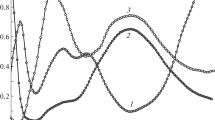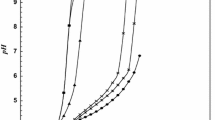Abstract
The complex formation of [Me2Sn]2+/[Me3Sn]+ with glucuronic [(HL-1)], mandelic [(HL-2)] and gallic [(HL-3)] acids has been studied potentiometrically in aqueous solution (I = 1.0 mol·dm−3 KNO3, 298 ± 0.1 K) and the speciation of various complex species has been evaluated as a function of pH. The results show that these hydroxycarboxylic acid ligands (HL) coordinate via the deprotonated oxygen atom of the carboxylate group resulting in the formation of mixed hydroxo species [Me2Sn(L)(OH)] (12.6–46.2 % in 1:1, 18.3–64.0 % in 1:2) along with [Me2Sn(L)]+ (9.2–18.0 % in 1:1, 14.8–27.8 % in 1:2) in Me2Sn(IV)–(HL) systems and single 1:1 species [Me3Sn(L)] (7.1–12.2 % in 1:1, 13.2–21.7 % in 1:2) in Me3Sn(IV)–(HL) systems at acidic pHs. At physiological pH ~7.0, the major species is [Me2Sn(OH)2] (96.0–97.5 % in 1:1, 92.4–97.2 % in 1:2) with minor amount of [Me2Sn(L)(OH)] (0.4–2.5 % in 1:1, 1.0–5.8 % in 1:2) in Me2Sn(IV)–(HL) systems. Similarly, in Me3Sn(IV)–(HL) systems the major species formed is [Me3Sn(OH)] (86.6–91.5 % in 1:1, 84.7–89.3 % in 1:2) with a very small amount of [Me3Sn(L)] (1.0–1.4 % in 1:1, 1.7–3.0 % in 1:2). At pH >8.0, only hydroxo species are formed, viz. [Me2Sn(OH)2], [Me2Sn(OH)3]− and [Me3Sn(OH)]. In all of the systems, no polymeric species were observed in the studied pH range. Multinuclear (1H, 13C and 119Sn) NMR studies, carried out at different pHs, confirmed the species formation and led us to propose their possible geometries in aqueous solution.





Similar content being viewed by others
References
Nath, M., Eng, G., Song, X., Beraldo, H., De Lima, G.M., Pettinari, C., Marchetti, F., Whalen, M.M., Beltrán, H.I., Santillan, R., Farfán, N.: Medicinal/biocidal applications of tin compounds and environmental aspects. In: Davies, A.G., Gielen, M., Pannell, K.H., Tiekink, E.R.T. (eds.) Tin Chemistry, Fundamentals, Frontiers, and Applications, 1st edn., Chap. 4. Wiley, London (2008)
Appel, K.E.: Organotin compounds: toxicokinetic aspects. Drug Metab. Rev. 36, 763–786 (2004)
Pagliarani, A., Trombetti, F., Ventrella, V. (eds.): Biochemical and Biological Effects of Organotins, 1st edn. Bentham Science, Sharjah (2012)
Champ, M.A.: A review of organotin regulatory strategies, pending actions, related costs and benefits. Sci. Total Environ. 258, 21–71 (2000)
Frache, R., Rivaro, P.: Occurrence, pathways and bioaccumulation of organometallic compounds in marine environments. In: Gianguzza, A., Pellizzetti, E., Sammartano, S. (eds.) Chemical Processes in Marine Environment, 1st edn., Chap. 10. Springer, Berlin (2000)
Gianguzza, A., Giuffrè, O., Piazzese, D., Sammartano, S.: Aqueous solution chemistry of alkyltin(IV) compounds for speciation studies in biological fluids and natural waters. Coord. Chem. Rev. 256, 222–239 (2012)
De Stefano, C., Foti, C., Gianguzza, A., Marrone, F., Sammartano, S.: Hydrolysis of methyltin(IV) trichloride in aqueous NaCl and NaNO3 solutions at different ionic strengths and temperatures. Appl. Organomet. Chem. 13, 805–811 (1999)
De Stefano, C., Foti, C., Gianguzza, A., Martino, M., Pellerito, L., Sammartano, S.: Hydrolysis of (CH3)2Sn2+ in different ionic media: salt effects and complex formation. J. Chem. Eng. Data 41, 511–515 (1996)
Hynes, M.J., Keely, J.M., McManus, J.: Investigation of the hydrolysis of [Sn(CH3)3(H2O)2]+ in aqueous solution by Tin-119 Nuclear Magnetic Resonance spectroscopy. J. Chem. Soc. Dalton Trans 12, 3427–3429 (1991)
Cigala, R.M., De Stefano, C., Giacalone, A., Gianguzza, A., Sammartano, S.: Hydrolysis of monomethyl-, dimethyl-, and trimethyltin(IV) cations in fairly concentrated aqueous solutions at I = 1 mol·L−1 (NaNO3) and T = 298.15 K. Evidence for the predominance of polynuclear species. J. Chem. Eng. Data 56, 1108–1115 (2011)
De Stefano, C., Foti, C., Gianguzza, A., Millero, F.J., Sammartano, S.: Hydrolysis of (CH3)3Sn+ in various salt media. J. Solution Chem. 28, 959–972 (1999)
El-Sherif, A.A.: Solution coordination chemistry of organotin(IV) cations with bio-relevant ligands. J. Solution Chem. 41, 1522–1554 (2012)
Takahashi, A., Natsume, T., Koshino, N., Funahashi, S., Inada, Y., Takagi, H.D.: Speciation of trimethyltin(IV): hydrolysis, complexation equilibria, and structures of trimethyltin(IV) ion in aqueous solution. Can. J. Chem. 75, 1084–1092 (1997)
Mohamed, M.M.A., Shoukry, M.M.: Interaction of diphenyltin(IV) dichloride with some selected bioligands. Chem. Pharm. Bull. 49, 253–257 (2001)
Nath, M., Kompelli, N.: Speciation and NMR spectrometric studies of interaction of di- and triorganotin(IV) moieties with 5′-guanosine monophosphate and guanosine in aqueous solution. J. Solution Chem. 43, 1184–1204 (2014)
Nath, M., Jairath, R., Mukherjee, G.N., Das, A.: Speciation of dimethyltin(IV) and trimethyltin(IV) cations with some biologically important ligands in aqueous medium: a potentiometric investigation. Indian J. Chem. 44A, 1602–1607 (2005)
Nath, M.: Sulaxna.: potentiometric and multinuclear NMR investigations of di-/trimethyltin(IV) cations with some heterocyclic thiones in aqueous media. New J. Chem. 31, 418–428 (2007)
Jankovics, H., Nagy, L., Kele, Z., Pettinari, C., D’Agati, P., Mansueto, C., Pellerito, C., Pellerito, L.: Coordination properties of the ACE inhibitor captopril towards Me2Sn(IV)2+ in aqueous solution, and biological aspects of some dialkyltin(IV) derivatives of this ligand. J. Organomet. Chem. 668, 129–139 (2003)
Pellerito, L., Nagy, L.: Organotin(IV)n+ complexes formed with biologically active ligands: equilibrium and structural studies, and some biological aspects. Coord. Chem. Rev. 224, 111–150 (2002)
Buck-Koehntop, B.A., Porcelli, F., Lewin, J.L., Cramer, C.J., Veglia, G.: Biological chemistry of organotin compounds: interactions and dealkylation by dithiols. J. Organomet. Chem. 691, 1748–1755 (2006)
Gielen, M.: Tin based anti-tumour drugs. Coord. Chem. Rev. 151, 41–51 (1996)
Siebenlist, K.R., Taketa, F.: Interactions of triethyltin bromide with components of the red cell. Toxicol. Appl. Pharmacol. 58, 67–75 (1981)
Ali, A.A., Upreti, R.K., Kidway, A.M.: Interaction of di- and tributyltin chloride with human erythrocyte membrane. Toxicol. Appl. Pharmacol. 38, 13–18 (1987)
Jancsó, A., Nagy, L., Moldrheim, E., Sletten, E.: Potentiometric and spectroscopic evidence for coordination of dimethytin(IV) to phosphate groups of DNA fragments and related ligands. J. Chem. Soc. Dalton Trans. 10, 1587–1594 (1999)
Hynes, M.J., Dowd, M.O.: Interactions of the trimethyltin(IV) cation with carboxylic acids, amino acids, and related ligands. J. Chem. Soc. Dalton Trans. 3, 563–566 (1987)
Buzás, N., Gajda, T., Kuzmann, E., Nagy, L., Vértes, A., Burger, K.: Coordination properties of l-cysteine and its derivatives towards diethyltin(IV) in aqueous solution. Main Group Met. Chem. 18, 641–649 (1995)
Capolongo, F., Giuliani, A.M., Giomini, M., Russo, U.: Interactions of organotin(IV) halides with reduced glutathione in aqueous solution. J. Inorg. Biochem. 49, 275–293 (1993)
Furlán, R.L.E., Mata, E.G., Mascaretti, O.A.: Efficient, non-acidolytic method for the selective cleavage of N-Boc amino acid and peptide phenacyl esters linked to a polystyrene resin. J. Chem. Soc. Perkin Trans. 1, 355–358 (1998)
Szorcsik, A., Nagy, L., Gyurcsik, B., Vankó, G., Krämer, R., Vértes, A., Yamaguchi, T., Yoshida, K.: Organotin(IV) complexes of polyhydroxyalkyl carboxylic acids and some related ligands. J. Radioanal. Nucl. Chem. 260, 459–469 (2004)
Arena, G., Gianguzza, A., Pellerito, L., Musumeci, S., Purrello, R., Rizzarelli, E.: Co-ordination properties of dialkyltin(IV) in aqueous solution. Thermodynamics of complex formation with carboxylic acids. J. Chem. Soc. Dalton Trans. 8, 2603–2608 (1990)
Fiore, T., Foti, C., Gianguzza, A., Orecchio, S., Pellerito, L.: D-glucuronate complexes of mono-, di- and triorganotin(IV) compounds: potentiometric and Mössbauer spectroscopic investigations. Appl. Orgamomet. Chem. 16, 294–301 (2002)
AlAlousi, A.S., Shehata, M.R., Shoukry, M.M., Mohamed, N.N.: Interaction of dimethyltin(IV) and trimethyltin(IV) with dehydroacetic acid. Chem. Spec. Bioavailab. 21, 1–6 (2009)
Gajda-Schrantz, K., Nagy, L., Fiore, T., Pellerito, L., Gajda, T.: Equilibrium and spectroscopic studies of diethyltin(IV) complexes formed with hydroxymono- and di-carboxylic acids and their thioanalogues. J. Chem. Soc., Dalton Trans 2, 152–158 (2002)
Cardiano, P., Giuffrè, O., Napoli, A., Sammartano, S.: Potentiometric, 1H NMR and ESI-MS investigation on dimethyltin(IV) cation–mercaptocarboxylate interaction in aqueous solution. New J. Chem. 33, 2286–2295 (2009)
Jansco, A., Gajda, T., Szorcsik, A., Kiss, T., Henry, B., Vanko, G., Rubini, P.: Potentiometric and spectroscopic studies on the dimethyltin(IV) complexes of 2-hydroxyhippuric acid. J. Inorg. Biochem. 83, 187–192 (2001)
Fazio, S.A., Uhlinger, D.J., Parker, J.H., White, D.C.: Estimations of uronic acids as quantitative measures of extracellular and cell wall polysaccharide polymers from environmental samples. Appl. Environ. Microbial. 43, 1151–1159 (1982)
Christensen, B.E., Kjosbakken, J., Smidsrod, O.: Partial chemical and physical characterization of two extracellular polysaccharides produced by marine, perphytic pseudomonas sp. strain NCMB 2021. Appl. Environ. Microbial. 50, 837–845 (1985)
Guard, H.E., Coleman III, W.M., Ross, M.M.: On the characterization of the reaction of organotin compounds with D-glucuronic acid. Carbohydr. Res. 235, 41–51 (1992)
Putten, P.L.: Mandelic acid and urinary tract infections. A. Van Leeuw. 45, 622–623 (1979)
Taylor, M.B.: Summary of mandelic acid for the improvement of skin conditions. Cosmet. Dermatol. 21, 26–28 (1999)
Kroes, B.H., van den Berg, A.J., Quarles van Ufford, H.C., Van Dijk, H., Labadie, R.P.: Anti-inflammatory activity of gallic acid. Planta Med 58, 499–504 (1992)
Inoue, M., Suzuki, R., Sakaguchi, N., Li, Z., Takeda, T., Ogihara, Y., Jiang, B.Y., Chen, Y.: Selective induction of cell death in cancer cells by gallic acid. Biol. Pharm. Bull. 18, 1526–1530 (1995)
Uozakia, M., Yamasaki, H., Katsuyama, Y., Higuchi, M., Higuti, T., Koyama, A.H.: Antiviral effect of octyl gallate against DNA and RNA viruses. Antiviral Res. 73, 85–91 (2007)
Kubola, J., Siriamornpun, S.: Phenolic contents and antioxidant activities of bitter gourd (Momordica charantia L.) leaf, stem and fruit fraction extracts in vitro. Food Chem. 110, 881–890 (2008)
Nath, M., Vats, M., Roy, P.: Design, spectral characterization, anti-tumor and anti-inflammatory activity of triorganotin(IV) hydroxycarboxylates, apoptosis inducers: in vitro assessment of induction of apoptosis by enzyme, DNA-fragmentation, acridine orange and comet assays. Inorg. Chim. Acta 423, 70–82 (2014)
Sizova, T.V., Yashina, N.S., Petrosyan, V.S., Yatsenko, A.V., Chernyshev, V.V., Aslanov, L.A.: X-ray structure investigation of trimethyltin α-phenyl-α-oxoacetate. J. Organomet. Chem. 453, 171–174 (1993)
Gajda-Schrantz, K., Nagy, L., Kuzmann, E., Vértes, A.: Coordination sphere symmetry of di-n-butyltin(IV) complexes containing ligands with O, O donor atoms. J. Radioanal. Nucl. Chem. 232, 151–158 (1998)
Terra, V.R., Barbiéri, R.S., CasteloBranco, P.A., Abras, A.: Synthesis and characterization of compounds diorganoestânicos acid dl-mandelic acid. Eclet. Chem. 23, 17–30 (1998)
Kohn, R., Kováč, P.: Dissociation constants of d-galacturonic and d-glucuronic acid and their O-methyl derivatives. Chem. Zvesti. 32, 478–485 (1978)
Cruywagen, J.J., Rohwer, E.A.: Equilibria and thermodynamic quantities for the reactions of molybdenum(VI) and tungsten(VI) with mandelate (α-hydroxybenzeneacetate). J. Chem. Soc. Dalton Trans. 21, 3433–3438 (1995)
Beltrán, J.L., Sanli, N., Fonrodona, G., Barrón, D., Özkan, G., Barbosa, J.: Spectrophotometric, potentiometric and chromatographic pKa values of polyphenolic acids in water and acetonitrile–water media. Anal. Chim. Acta 484, 253–264 (2003)
Natsume, T., Aizawa, S., Hatano, K., Funahashi, S.: Hydrolysis, polymerization and structure of dimethyltin(IV) in aqueous solution. Molecular structure of the polymer [(SnMe2)2(OH)3]ClO4. J. Chem. Soc. Dalton Trans. 19, 2749–2753 (1994)
Caldeira, M.M., Ramos, M.L., Oliveira, N.C., Gil, V.M.S.: Complexes of vanadium(V) with α-hydroxycarboxylic acids studied by 1H, 13C, and 51V nuclear magnetic resonance spectroscopy. Can. J. Chem. 65, 2434–2440 (1987)
Portanova, R., Lajunen, L.H.J., Tolazzi, M., Pisspanen, J.: Critical evaluation of stability constants for α-hydroxycarboxylic acid complexes with protons and metal ions and the accompanying enthalpy changes–Part II: aliphatic 2-hydroxycarboxylic acids. Pure Appl. Chem. 75, 495–540 (2003)
Bermejo, E., Carballo, R., Castiñeiras, A., Lago, A.B.: Coordination of α-hydroxycarboxylic acids with first-row transition ions. Coord. Chem. Rev. 257, 2639–2651 (2013)
Lockhart, T.P., Manders, W.F.: Structure determination by NMR spectroscopy. Correlation of [2 J(119Sn-1H)] and the Me–Sn–Me angle in methyltin(IV) compounds. Inorg. Chem. 25, 892–895 (1986)
Surdy, P., Rubini, P., Buzás, N., Henry, B., Pellerito, L., Gajda, T.: Interaction of dimethyltin(IV)2+ cation with Gly-Gly, Gly-His, and some related ligands. A new case of a metal ion able to promote peptide nitrogen deprotonation in aqueous solution. Inorg. Chem. 38, 346–352 (1999)
Holeček, J., Nádvorník, M., Handlíŕ, M., Lyčka, A.: 13C and 119Sn NMR spectra of di-n-butyltin(IV) compounds. J. Organomet. Chem. 315, 299–308 (1986)
Acknowledgments
Ms. Mridula is thankful to the University Grants Commission (UGC), New Delhi, India, for awarding a Senior Research Fellowship (Grant No. 6405-13-044(061)).
Author information
Authors and Affiliations
Corresponding author
Electronic supplementary material
Below is the link to the electronic supplementary material.
Rights and permissions
About this article
Cite this article
Mridula, Nath, M. Equilibrium and Multinuclear NMR Spectroscopic Studies of Di- and Trimethyltin(IV) Moieties with Hydroxycarboxylic Acids in Aqueous Medium. J Solution Chem 45, 445–462 (2016). https://doi.org/10.1007/s10953-016-0448-z
Received:
Accepted:
Published:
Issue Date:
DOI: https://doi.org/10.1007/s10953-016-0448-z




